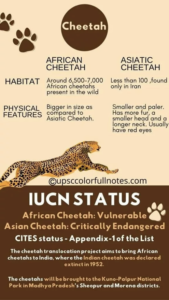Project Cheetah.
Relevance
- GS Paper – 3: Conservation, Environmental Pollution, and Degradation, Environmental Impact Assessment.
- Tags: #Cheetah #Cheetahdeath #Cheetahreintroduction # NamibiaCheetah #KunoNationalPark #AsiaCheetah #AfricanCheetah #GSPaper-3.
Why in the news?
Recently one year has passed 8 cheetahs arrived from Namibia and were released into Kuno National Park on 17th September 2022 by the Prime Minister of India.
Project Cheetah
- Project Cheetah is India’s cheetah relocation programme. This is the first time a wild, large carnivore species has been introduced across an ocean.
- Over the next ten years, the project will import 5 to 10 animals per year until a self-sufficient cheetah population is established.
- Indian cheetah history In India, Asiatic Cheetahs were once widespread, but the last one there passed away in 1952.
- Southeast African cheetahs have been reintroduced; they were transported from Namibia and South Africa.
- Location: As part of Project Cheetah, animals are relocated from South African and Namibian woodlands to Madhya Pradesh’s Kuno National Park.
- Twenty cheetahs have been added to Kuno National Park since last year in an effort to build a population that may roam freely.
- The National Tiger Conservation Authority (NTCA) is the top organisation in charge of carrying out Project Cheetah.
- The Ministry of Forests, Environment, and Climate Change is responsible for NTCA.
- The Indian government is receiving assistance from the Cheetah Conservation Fund (CCF) in returning cheetahs to India.
Criticisms against this project
- Scientific foundation – Wildlife experts claimed that India’s plan to reintroduce cheetahs was based on an erroneous assumption. Additionally, they asserted that the plan ignores important scientific findings from current demographic studies on free-roaming cheetahs.
- Site selection – According to a number of wildlife and conservation specialists, Kuno National Park would not be a viable environment for supporting a sizable population of cheetahs.
- Space needs – Cheetahs generally need vast habitats covering thousands of square miles to roam freely, while Kuno National Park is only predicted to have 500 square miles or less. Kuno’s habitat is insufficient to support such a huge population of cheetahs.
- The Supreme Court’s bench expressed alarm over a certain area’s high cheetah population.
- Alternatives – It also advised looking into ecosystems that might be better suited than Kuno. In Gandhisagar, Madhya Pradesh, there are proposals to create a second reserve and a centre for cheetah rehabilitation.
- Approach – A multidisciplinary approach is required for the protection of carnivores in areas where human activity has a significant impact.
- Prolonged captivity – Quarantining cheetahs for extended periods have affected their adaptive capabilities and given them psychological adjustment problems, making them more vulnerable.
Kuno Palpur National Park
- Location: Kuno National Park lies in Sheopur district of Madhya Pradesh in Central India near the Vindhyan Hills.
- With an area of 748 sq. km, the park is located within the larger Kuno Wildlife Division.
- Initially established as a wildlife sanctuary, it was only in 2018 that the government changed its status into a national park.
- Named after the Kuno River (One of the main tributaries of the Chambal River) that cuts across it, Kuno is primarily a grassland region.
- Flora and Fauna: The protected area of the forest is home to the jungle cat, Indian leopard, sloth bear, Indian wolf, striped hyena, golden jackal, Bengal fox and dhole, along with more than 120 bird species
- Kuno National Park was selected under ‘Action Plan for Introduction of Cheetah in India’.
Arguments in support of this project
- It’s too soon to pass judgement, but The Cheetah Conservation Fund (CCF) has stated that India has made progress.
- It emphasized the fact that only once cheetahs have firmly established their territories can their home ranges be identified with accuracy.
Knowledge
- India is improving its understanding of cheetahs and the wide spectrum of veterinary issues and behavioral traits related to cheetahs that are allowed to wander freely. This information has a favorable effect on the project’s long-term success.
Breeding favorable
- Cheetahs from two different nations have different genetic make-ups, and careful breeding can preserve that diversity.
- The successful birth of three female cubs indicates the suitable habitat of Kuno NP. Cheetahs have high reproduction rates in favorable ecological settings.
Protracted process
- An evaluation that takes place over a long period of time is necessary to determine whether wildlife breeding programs are effective.
- A genetically healthy population of cheetahs can exist for an extended period of time, similar to Project Tiger, which works to conserve rhinoceros and Asiatic lions. Consequently, it is too soon to evaluate the program.
Damages: In every project to reintroduce an animal, fatalities are unavoidable.
Ecological Benefit: The cheetah restoration project raises the value of savannahs and grasslands, which have long been under-utilized.
Biodiversity Benefit: The Cheetah is the flagship species of grasslands and its conservation will enhance the grassland biodiversity.
Cheetah Conservation Fund
- The Cheetah Conservation Fund (CCF) is an international non-profit organization.
- It is the longest-running cheetah conservation project in Africa.
NTCA
- In 2005, the National Tiger Conservation Authority (NTCA) was founded.
- Under the Ministry of Environment, Forests, and Climate Change, the NTCA is a statutory body.
- It was established in accordance with Section 38 L (1) of the Wildlife (Protection) Act of 1972.
- Its main office is in New Delhi.
- Its chairman is the Union Minister for Environment, Forests, and Climate Change.
African Cheetah:
- Scientific Name: Acinonyx jubatus jubatus.
- Habitat: African Savannahs.
- Characteristics: They are bigger in size as compared to Asiatic Cheetah.
- Conservation Status:
- IUCN status: Vulnerable.
- CITES Appendix I.
Asiatic Cheetah:
- Characteristics: Smaller and paler than the African cheetah.
- IUCN status: Critically Endangered.
- Status in India: Declared extinct in India in 1952.
- Distribution: Only 40-50 and found only in Iran.
Source: The Hindu, Indian Express.
Mains Questions
Discuss the causes of the extinction of cheetahs in India. What are the ecological challenges associated with reintroduction of Cheetah in India?





